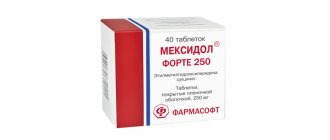Serlift
Monoamine oxidase inhibitors (MAOIs).
Severe complications have been observed with the simultaneous use of sertraline and MAOIs, including selectively acting (selegiline) MAOIs and those with a reversible type of action (moclobemide). The development of serotonin syndrome is possible (see section “Overdose”).
Medicines that depress the central nervous system and ethanol.
The combined use of sertraline and substances that depress the central nervous system requires monitoring. Not compatible with ethanol.
Coumarin derivatives:
when they are co-administered with sertraline, a significant increase in prothrombin time is observed - in these cases it is recommended to monitor the prothrombin time at the beginning of treatment with Sirlift and after its discontinuation.
Cimetidine.
When used simultaneously, it significantly reduces the clearance of sertraline.
Drugs metabolized by cytochrome P450 isoenzyme 2D6.
Although sertraline has only the potential to cause clinically significant suppression of the 2D6 isoenzyme of cytochrome P450, however, when used together with drugs metabolized by this isoenzyme (desipramine, tricyclic antidepressants, class I antiarrhythmic drugs - propafenone and flecanaid), lower doses of sertraline are used, and when Increased doses of these drugs may be required when discontinuing sertraline.
Drugs metabolized by other cytochrome P450 enzyme systems.
Experiments to study the interaction
in vitro
showed that the beta-hydroxylation of endogenous cortisol carried out by the isoenzyme CYP 3A3/4, as well as the metabolism of carbamazepine and terfenadine, do not change with long-term administration of sertraline at a dose of 200 mg per day. Plasma concentrations of phenytoin and warfarin also do not change with long-term administration of sertraline at the same dose. Thus, we can conclude that sertraline does not inhibit CYP2C9.
Sertraline does not affect the concentration of diazepam in the blood serum, which indicates the absence of inhibition of the CHZ 2C19 isoenzyme. Based on in vitro
Sertraline has virtually no effect or minimal inhibition of the CYP1A2 isoenzyme.
Sumatriptan.
If combined with sertraline, patients experienced weakness, hyperreflexia, and impaired coordination of movements, therefore, if such a combination is necessary, patients should be monitored.
Tolbutamide:
sertraline reduces the clearance of tolbutamide (monitoring of blood glucose is necessary during simultaneous use)
Lithium.
The pharmacokinetics of lithium do not change with concomitant treatment with sertraline. However, tremor is more often observed when they are used together.
Drugs affecting serotonergic transmission
. When replacing one serotonin reuptake inhibitor with another, there is no need for a washout period. However, caution is required when doing this. Incompatible with tryptophan and phenifluramine.
Induction of microsomal liver enzymes.
Sertraline causes minimal induction of liver enzymes. The simultaneous administration of sertraline and antipyrine at a dose of 200 mg leads to a significant decrease in the half-life of antipyrine, although this occurs in only 5% of cases.
Atenolol.
When administered together, sertraline does not change the 13-adrenergic blocking effect of atenolol.
Glibenclamide and digoxin.
When sertraline was administered in a daily dose of 200 mg, no drug interactions with these drugs were detected.
Nonsteroidal anti-inflammatory drugs, acetylsalicylic acid:
When used together, the risk of bleeding increases.
Surlift tablet film 50 mg x28
INSTRUCTIONS
(information for specialists) on the medical use of the drug SERLIFT
Registration number:
Trade name of the drug: Serlift
International nonproprietary name: sertraline
Dosage form: film-coated tablets.
Compound:
Tablets 50 mg
Active substance: sertraline hydrochloride 55.96 mg, equivalent to 50 mg sertraline Excipients: calcium hydrogen phosphate, microcrystalline cellulose (Avitsel RN, , , 101), , , microcrystalline cellulose, , (Avitsel, , RN, , , 102), , , hyprollose-L, sodium carboxymethyl starch, magnesium stearate. . . . purified water (evaporates during the production process).
Shell: white opadry OY-S-58910, purified water (evaporates during the production process). Composition of opadry white dye OY-S-58910: hypromellose, titanium dioxide, macrogol 400, talc.
Tablets 100 mg
Active substance: sertraline hydrochloride 111.92 mg, equivalent to 100 mg of sertraline Excipients: calcium hydrogen phosphate, microcrystalline cellulose (Avicel RN, , 101), , microcrystalline cellulose, , (Avitsel, RN, , 102), , , hyprollose-L, sodium carboxymethyl starch, magnesium stearate, , , , purified water (evaporates during the production process).
Shell: white opadry OY-S-58910, purified water (evaporates during the production process). Composition of opadry white dye OY-S-58910: hypromellose, titanium dioxide, macrogol 400, talc. Description:
50 mg tablets: white or off-white, oval-shaped, film-coated tablets with “50” engraved on one side and scored on the other.
100 mg tablets: white or off-white, oval-shaped, film-coated tablets with “100” engraved on one side and scored on the other. Pharmacotherapeutic group: antidepressant Code ATX:N 06A B06
,
Pharmacological properties of Pharmacodinica
An antidepressant, a selective serotonin reuptake inhibitor, enhances its effects, has a weak effect on the reuptake of norepinephrine and dopamine, and in therapeutic doses blocks the uptake of serotonin in human platelets. Inhibition of serotonin reuptake activity increases serotonergic transmission, which leads to subsequent inhibition of adrenergic activity at the locus ceruleus. Sertraline also inhibits the excitation of serotonin neurons in the raphe region (midline of the medulla oblongata), which leads to an initial increase in the activity of the locus coeruleus followed by a decrease in the activity of postsynaptic beta-adrenergic receptors and presynaptic alpha-2 adrenergic receptors.
Does not cause drug dependence, does not have m-anticholinergic and cardiotoxic effects. Does not enhance the activity of the sympathetic nervous system. It has no affinity for m-cholinergic, serotonin, dopamine, adrenergic, histamine, GABA or benzodiazepine receptors, and does not inhibit monoamine oxidase (MAO). Unlike tricyclic antidepressants in the treatment of depression or obsessive-compulsive disorders (obsessive states), it does not increase body weight. The initial effect is observed within 7 days, the full effect is observed after 2-4 weeks. Pharmacokinetics
Absorption of sertraline is high but slow. Maximum concentration in blood plasma is achieved 4.5-8.4 hours after taking the drug orally. The equilibrium concentration of sertraline in blood plasma is achieved within a week with a single daily dose. Bioavailability during meals increases by 25%, while the time to reach maximum concentration is shortened.
Distribution. The total binding of sertraline to plasma proteins is 98%. Volume of distribution >.20 l/kg.
Metabolism and excretion. Sertraline undergoes extensive metabolism during its first passage through the liver, undergoing N-demethylation. Its main metabolite, N-desmethylsertraline, is less active than the parent compound. Metabolites
excreted in urine and feces in equal quantities. About 0.2% of sertraline is excreted unchanged by the kidneys. The half-life of the drug is 22-36 hours, does not depend on age and gender. For N-desmethylsertraline this figure is 62-104 hours.
The half-life of sertraline and the area under the plasma concentration curve (AUC) increase with impaired liver function. Regardless of the severity of renal failure, the pharmacokinetics of sertraline do not change with its continuous use. Sertraline passes into breast milk. There is no data on its ability to cross the blood-placental barrier. Sertraline is not dialysable. Indications
• , , , , , , , , Depressive conditions of various etiologies, including those accompanied by feelings of anxiety (treatment and prevention)
• , , , , , , , , Panic disorders with and without agoraphobia
• , , , , , , , , , Obsessive-compulsive disorder (OCD)
• , , , , Post-traumatic stress disorder (PTSD) Contraindications
• , , , , , , , , , Hypersensitivity to the active substance or other ingredients included in the drug
• , , , , , , , , , , Combined use of sertraline and MAO inhibitors
• , , , , , , , , , , Combined use of sertraline with tryptophan or phenylfluramine
• , , , , , , , , , Combined use with pimozide
• , , , , , , , , , Epilepsy during an exacerbation
• , , , , , , , , , Children under 6 years of age
• , , , , , , , , , , Pregnancy and lactation
With caution: organic diseases of the brain (including mental retardation), manic states, epilepsy (with a history and without exacerbation), liver and/or renal failure, weight loss, in children over 6 years of age. Pregnancy and lactation
Controlled trials of sertraline in pregnant women have not been conducted; therefore, during pregnancy, the drug can be prescribed only if the expected benefit to the mother outweighs the possible risk to the fetus. Women of childbearing potential receiving treatment with Sirlift should use adequate methods of contraception. Sertraline is found in dairy milk, so the use of Surlift in nursing women is not recommended. If treatment is necessary, it is better to stop breastfeeding.
Directions for use and doses
Depression and OCD: Adults
Inside. 50 mg 1 time per day in the morning or evening, regardless of meals. If there is no effect, a gradual (over several weeks) dose increase to 200 mg/day (by 50 mg per week) is possible. Some clinicians recommend an initial dose of 25 mg/day for 1-2 days.
In patients with OCD, 8-12 weeks of therapy may be required to achieve good results.
Panic disorders and PTSD: initial dose - 25 mg / day in the morning or evening, followed by an increase over 1 week to 50 mg / day, and then gradually by 50 mg per week the dose can be increased to 200 mg / day. The therapeutic effect is usually achieved within 7 days from the start of treatment. However, to achieve the full therapeutic effect, regular use of the drug is required for 2-4 weeks.
When conducting long-term maintenance therapy, it is prescribed at the minimum effective level.
dose, which is subsequently changed depending on the effect.
In elderly patients there is no need for special dose selection.
Patients with impaired liver function require special attention when treated with Sirlift.
In case of severe liver dysfunction, the dose of the drug should be reduced or increased
intervals between doses. In patients with impaired renal function, specifically select
no dose required.
Children with OCD
For children 6 to 12 years of age, the starting dose is 25 mg sertraline once daily, morning or evening. After a week, the dose can be increased to 50 mg once a day. In adolescents 13-17 years old, the initial dose is 50 mg/day in the morning or evening once. The daily dose can be gradually increased by 50 mg per week to a maximum dose of 200 mg/day. The lower body weight of children compared to adults should be taken into account, and when prescribing a dose of more than 50 mg/day, children should be carefully monitored in order to discontinue the drug at the first sign of overdose.
It may take 8-12 weeks of therapy to achieve good results. Side effect
From the cardiovascular system: postural hypotension, tachycardia, hyperemia
skin or “flushes” of blood to the .type.
From the senses: visual impairment
From the gastrointestinal tract: rarely - anorexia, increased appetite (possibly as a result of eliminating depression), dry mouth, nausea, vomiting, diarrhea, stomach or abdominal cramps, flatulence or pain.
From the drinking system: headache, dizziness, insomnia, drowsiness, tremor, movement disorders (extrapyramidal symptoms, changes in gait), akathisia, convulsions, paresthesia, hypoesthesia, amnesia, symptoms of depression, hallucinations, aggressiveness, anxiety, psychomotor agitation, psychosis, depersonalization, nervousness, hypomania, mania, panic reactions, yawning, serotonin syndrome (see section “Overdose”),
From the musculoskeletal system: arthralgia, myalgia
On the part of the hepato-biliary system: rarely - pancreatitis, hepatitis, jaundice, liver failure, asymptomatic increase in the activity of “liver” transaminases (aspartate aminotransferase and alanine aminotransferase).
From the urinary system: urinary retention and urinary incontinence.
From the reproductive system: sexual dysfunction (delayed ejaculation, decreased
potency and/or libido, anorgasmia), dysmenorrhea, galactorrhea.
On the skin side: rash (rarely - exudative erythema multiforme, photosensitivity), angioedema, ecchymosis, itching and anaphylactoid reactions. From the metabolic and endocrine system: hyponatremia (syndrome of inappropriate secretion of antidiuretic hormone (ADH), hyperprolactinemia.
From the hematopoietic system


